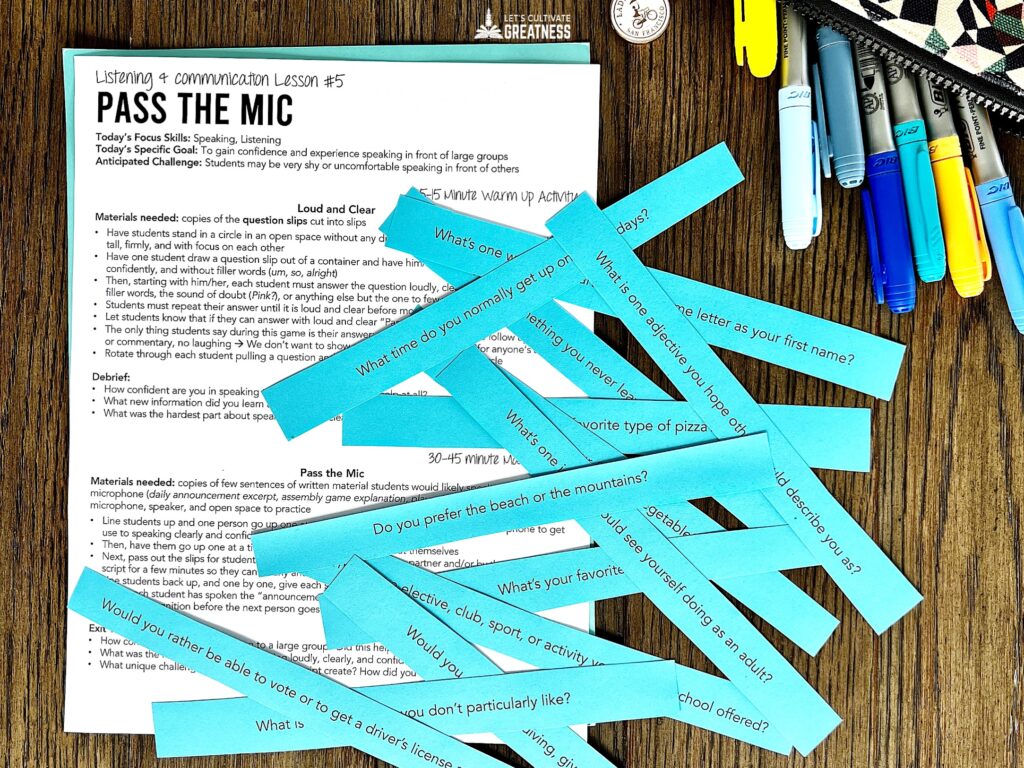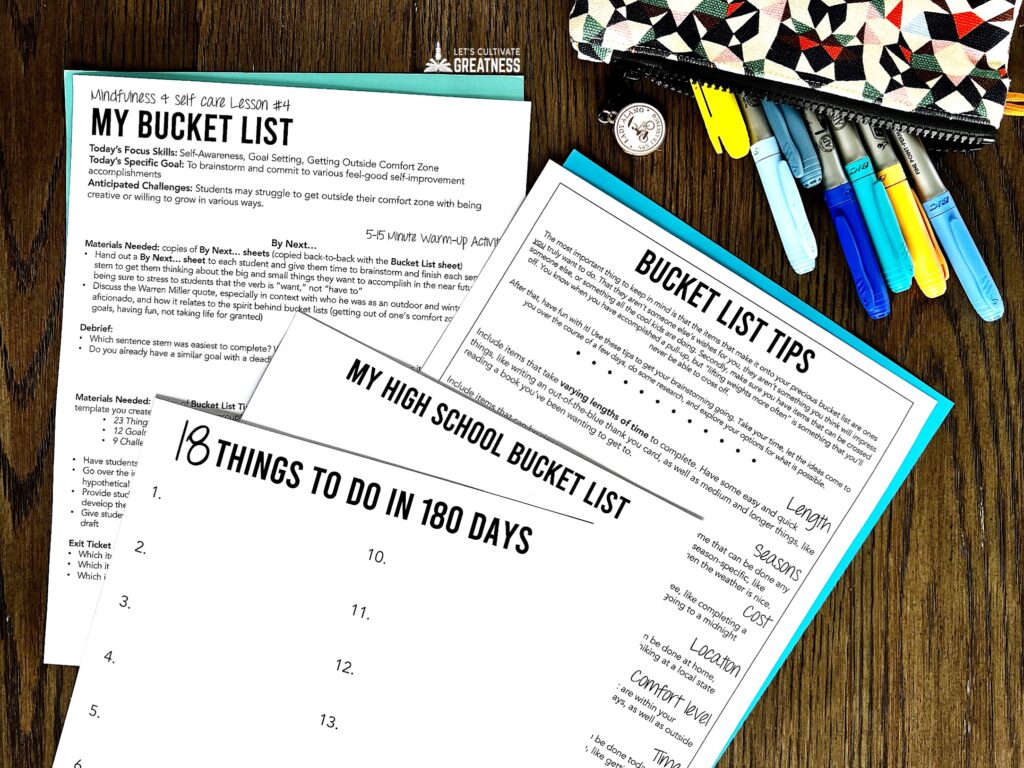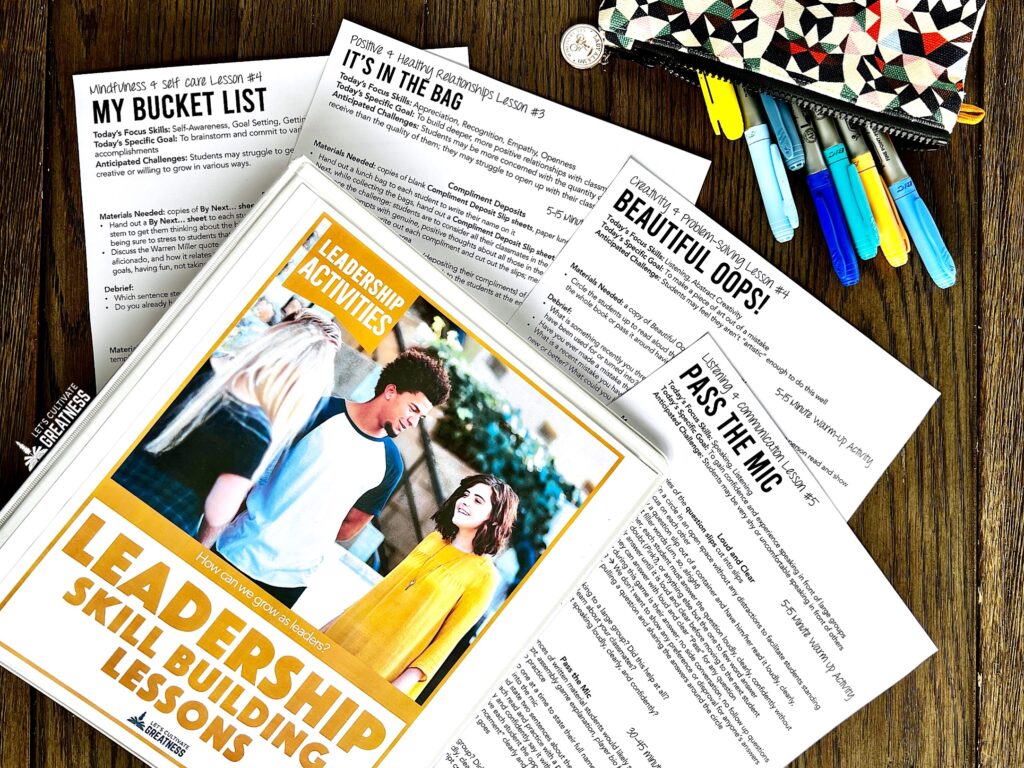My favorite part of teaching Leadership class is also the most underrated: having the chance to strengthen life skills!
When else do active listening, empathy, or thinking outside the box get to be the focus of class time? I love it! These are the types of things we hope students pick up somehow but rarely have opportunity to teach explicitly.
Leadership skills, especially at the middle or high school level, encompass many life skills—communication, compassion, teamwork, creativity, and social-emotional intelligence. It goes way beyond just leading people.
The best part is being able to plot precisely in the year a particular skill is best to focus on so they carry more meaning. Like practicing speaking skills right before an assembly. Or doing a gratitude lesson during November.
If this is your first time teaching Leadership, you aren’t able to fully predict which skills need work and when. So, give yourself grace and take lots of notes during your first year. Then, before the following school year, use them to plan out your calendar.
Below are 5 of my favorite activities to teach essential leadership skills. These come from my year-long leadership skills activity bundle, which includes 30 one-hour print-and-teach lessons.
1. Build Team Work by Hosting a Scavenger Hunt Swap
This activity is perfect for right at the start of the year!
Divide your students into groups of 3-4, giving each a shopping bag and a blank sheet of paper, and head outside. Be sure to review the defined boundaries for this activity (ex. “on campus, except parking lot”).
Give groups a few minutes to brainstorm ten items that are
- findable and accessible on campus
- nobody’s personal property
- fit inside the provided bags
Some examples could be a rock from the courtyard, a napkin from the cafeteria, a sticky note from the attendance office counter.
Gather up the lists, then randomly pass them back out to groups. With all members sticking together in their group, they must find the items on their list within a set amount of time.
Debrief by asking: “What was the most challenging part of moving together as a team?”
Click to get more fun teambuilding lessons.
2. Practicing Microphone Speaking Skills

Plan this one right before the first assembly.
Ahead of time, type up a bunch of questions that take just a few words or a sentence to answer. Just be sure the questions are ones every student can easily and comfortably answer. So, no sensitive or personal questions.
Cut them into slips for students to pull randomly.
Some examples of questions to ask:
- Would you ever go skydiving?
- What’s your favorite season and why?
- Is a hotdog a sandwich?
- What’s your favorite meal?
Head down to the auditorium or gym (wherever you hold assemblies!) and power up the microphone. Stand in a line or circle, pull a question, and have students, one by one, answer the questions in the microphone.
After several rounds, students should know how close to hold it and how loudly to speak and feel confident with their own voice.
Start with questions that require only one-word answers and work up to ones that require a sentence.
Debrief by asking: After several rounds, what trick seemed to work the best to speak loudly, clearly, and confidently?
Click here for more print-and-go speaking and listening lessons.
3. Strengthen Relationships among Students
This one is great to do a few weeks into the school year since it’s a more vulnerable team-building activity.
Grab a bunch of paper lunch bags and hand one to each student to decorate with well-known things that represent them—sports a part of, instruments played, clubs a member of, stuff like that.
Task students to bring something that fits inside the bag representing an aspect them that isn’t widely known. Like someone who likes to cook for their family bringing in a bottle of their favorite spice or a someone whose happy spot is the beach bringing in a seashell. Without showing anyone, students put their item into their bag.
Put the filled bags into a box and have students take one out. Have them examine the outside to see if they can guess the owner. Then, pull out the secret item and guess what it might represent. The owner can then share a bit about what the bag and item mean.
Debrief by asking: How can we create a group where we feel safe sharing our inner selves?
Click for more great lessons on building healthy relationships.
4. Practice Creative Thinking with Oops Art
Save this one for a less hectic time of year since it can be scheduled at any time. All you need are some basic art supplies like paint, scissors, glue, and construction paper.
Get a copy of the children’s book Beautiful Oops! by Barney Saltzberg and read it aloud with students or have them each read a page aloud, then pass it on to the next. Yes, even high schoolers get a kick out of storytime!
Saltzberg includes nine “oopses” in the book, like a tear or paint spill. Assign each student one to create.
Redistribute them back out, challenging students to now create a masterpiece out of the oops they got. Afterward, make a bulletin board display out of the artworks.
Debrief by asking: How can we remind ourselves to look for the beauty in or a new purpose for a “mistake”?
Click to get more creative and problem-solving lessons.
5. Encourage Goal Setting with a Bucket List

This works well at many points in the year—the start of the school year, the new year, or second semester. Or even right before summer break!
This activity shows students that leadership skills include personal leadership too!
Decide a number theme that works for when you’re doing this:
- 18 Things to Do in 180 Days
- 9 Challenges for the 90 Days of Summer
- 11 Things to Do by the End of 11th Grade
Start by having students take a minute or two to close their eyes and envision how the perfect summer or school year would look. You may also want to make and share your own bucket list with students.
The trick to a successful bucket list is to have a range of activities. Accomplishments shouldn’t all be expensive, time-consuming, or outside of comfort zones. A few “reach” goals should be balanced with ones that are free, can be done solo or at any time, and don’t much of time.
Since lists should be personal, just ask for volunteers to share an item on their list to close the lesson.
Debrief by asking: What’s something you’re excited to do that you’d never thought of until this activity?
Click here for more ready-to-go mindfulness and personal growth lessons.
I hope these activity ideas help you incorporate more leadership skills into your classroom!
Get all these activities as ready-to-go leadership lessons in my Leadership Skills bundle, complete with teacher guides, warm-ups, handouts, and exit slips. With over 30 hour-long lessons to pick from, you will be set for the whole school year!

Feature image photo credit: Perry Grone








